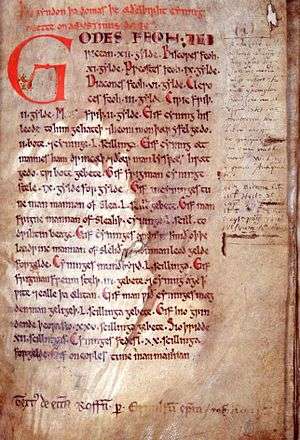Textus Roffensis

The Textus Roffensis (Latin for "The Tome of Rochester"), fully entitled the Textus de Ecclesia Roffensi per Ernulphum episcopum ("The Tome of the Church of Rochester up to Bishop Ernulf") and sometimes also known as the Annals of Rochester, is a mediaeval manuscript that consists of two separate works written sometime between 1122 and 1124. It is catalogued as "Rochester Cathedral Library, MS A.3.5" and is currently on display in a new exhibition at Rochester Cathedral, Rochester, Kent.[1] It is thought that the main text of both manuscripts was written by a single scribe, although the glosses to a Latin entry were made by a second hand.[2]
Name
A textus was a book with a decorated cover suitable to be kept in the church by the high altar. The term does not mean a text concerning Rochester Cathedral. A liber was a less decorated book, suitable only for the cloister. It is rare that a secular book is a textus, and the name given to the Textus Roffensis by the cathedral is considered indicative of the book's importance during the Middle Ages.[3]
History
The two manuscripts were bound together in around 1300.[3] The first part is a collection of documents which includes the Law of Æthelberht, attributed to Æthelberht of Kent (c. 560–616), and the 1100 coronation charter of Henry I of England. The Law of Æthelberht is the oldest surviving English law code and the oldest Anglo-Saxon text in existence. The second part of the Textus Roffensis is the oldest of the Rochester Cathedral registers. The entire volume consists of 235 vellum leaves.[3][4]
Over the centuries, the Textus Roffensis has been loaned, lost and recovered on several occasions and has been in the custody of a variety of different people and places: it is now held at the Medway Archives Office in Strood. Sometime between 1708 and 1718 the book was immersed for several hours in either the River Thames or the River Medway when the ship transporting it overturned; water damage is apparent on a number of pages.[3]
The book was named 'Britain's Hidden Treasure' by the British Library, was the subject of a conference at the University of Kent in 2010.[4] It has been digitised and published on line by The University of Manchester's Centre for Heritage Imaging and Collection Care.[5][6]
Footnotes
- ↑ It was deposited in the Kent Archives Office in Maidstone in 1969, and was transferred to the Medway office in 1992 following its creation.
- ↑ Treharne, Textus Roffensis.
- 1 2 3 4 Medway Archives, The Textus Roffensis.
- 1 2 University of Kent, England’s 'Hidden Treasure'.
- ↑ "A book 100 years older than the Magna Carta goes digital". University of Manchester.
- ↑ Facsimile of Textus Roffensis, John Rylands Library of the University of Manchester
Sources
- Treharne, Elaine. "Textus Roffensis". The Production and Use of English Manuscripts 1060 to 1220. University of Leicester. Retrieved 17 November 2012.
- "England's 'Hidden Treasure' is the focus of Kent conference and exhibition". University of Kent. 2010. Retrieved 7 August 2012.
- "Textus Roffensis". John Rylands Library. Retrieved 3 January 2014. (online facsimile)
Further reading
- Arnold, A. A. (1898). "Preliminary Account of 'Notes on the Textus Roffensis', by Dr. F. Liebermann". Archaeologia Cantiana. xxiii: 94–112. Retrieved 17 November 2012.
- O'Brien, Bruce R; Bombi, Barbara, eds. (2015). Textus Roffensis : law, language, and libraries in early medieval England. Turnhout, Belgium: Brepols.
- Parkes, Malcolm B. (2008). Their Hands Before Our Eyes: A Closer Look at Scribes. Aldershot: Ashgate. ISBN 978-0-7546-6337-9.
- Richards, Mary P. (1988). Texts and Their Traditions in the Medieval Library Rochester Cathedral Priory. Philadelphia: American Philosophical Society. ISBN 0-87169-783-1.
- Sawyer, Peter (1962) [1957]. "Textus Roffensis, Parts I and II". Early English Manuscripts in Facsimile. Copenhagen: Rosenkilde and Bagger. VII and XI.
External links
- Medway Council City Ark "The Textus Roffensis" - scanned images of each of the pages of the Textus Roffensis.